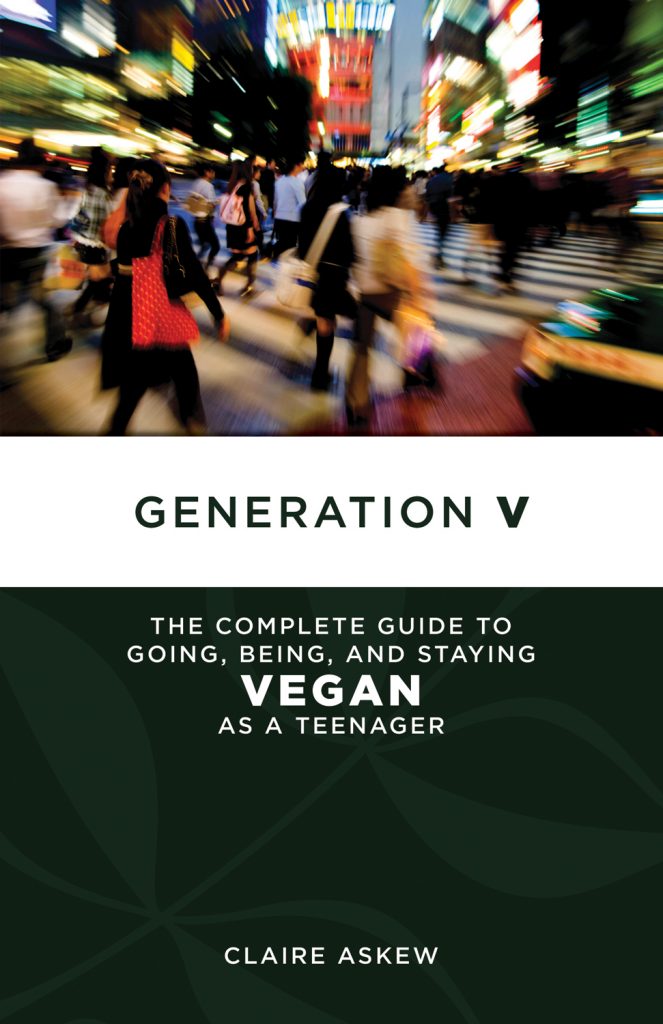By Mark Robison
Reno Gazette Journal
June 29th, 2011
excerpt from blog series Vegan Wednesday
Book for teens wanting to go vegan
Speaking of books about going vegan, a new one came out this month called Generation V: The Complete Guide to Going, Being and Staying Vegan as a Teenager by 21-year-old Claire Askew. (It’s by PM Press, my favorite publisher, of whom I’m a “friend”,
meaning I give them a set amount of money every month to support its
efforts and in exchange, they send me a copy of everything they
publish.)
Generation V is short and superb. It’s exactly
the book I wish I’d had in my teens—and it’s the kind of book I’d write
now. It’s conversational yet packs a ton of information with everything
you’d want to know: how to deal with parents and friends (with
responses to most questions you’ll get hit with), what you need to know
healthwise, books to check out, companies that make vegan beauty
products, vegan musicians and songs (including the music video below),
resource websites, websites to meet other vegan teens, recipes
(including the one below), how to leaflet and do other outreach
activities, quotes (including the one from Matt Ball above), and much
more.
Here’s an excerpt responding to the common statement “I could never give up cheese!”:
Cheese
is tough for a lot of people to give up. Even when you’ve phased all
other animal products out of your diet, cheese can be the one thing
holding you back. But there’s actual reason for this—cheese is a drug!
Mmhmm. Cheese’s main protein, casein (found irritatingly often in some
nondairy cheeses), breaks down during digestion to form compounds
similar to morphine called casomorphins. The reason for this, class, is
that milk is supposed to be given to calves from their moms. The
casomorphins are intended to draw that calf back to the mother’s udders
so the calf will keep drinking the milk and grow up. Instead,
casomorphins give your stomach and brain a relaxed, slightly drowsy
feeling (it’s called “comfort food” for a reason) and draw you back to
the fridge.
So what can you do to break the addiction? What I
think is most effective is thinking of how that cheese got to you. Don’t
think that you’re a horrible person for eating cheese, just think about
how that cheese came to your plate. Think about a cow on her way to be
artificially impregnated against her will. Think about that same cow
moaning and wailing months later when her child is taken away from her.
Think about that calf chained in a crate in the dark [male calves become
veal], and ask yourself, is it really worth it? . . .
Look for
brands [of cheese] that specifically say vegan on the package, such as
Daiya (my favorite), Cheezly, or Follow Your Heart. The world of vegan
cheese is a fast-paced one. When I first started writing this book in
2007, vegan cheese was either readily available but kind of odd-tasting,
or delicious and hard to find (like, only-in-Europe hard). Now, though,
that isn’t the case. Daiya, for example, really tastes like dairy
cheese (even my omnivorous family likes it), melts and gets stringy like
dairy cheese, and is sold in every Whole Foods store (and other places
as well) throughout the nation. There are all different kinds of vegan
cheese from shreds to slices to spreads in every flavor from bacon
(really) to Monterey Jack, and trying different brands to find out which
you like best is no longer treacherous, plastic-tasting labyrinth. It
only takes about three weeks for you to grow new tastebuds (and thus for
new tastes to become normal to you), too.
One correction to the
book. It says the great Peaceful Prairie is the only abolitionist farm
animal sanctuary in the world, meaning it doesn’t promote bigger cages
and longer chains but seeks only the end of animal exploitation. There
is one other, although it doesn’t advertise itself as such:
CockadoodleMoo Farm Animal Sanctuary right here in Reno.







